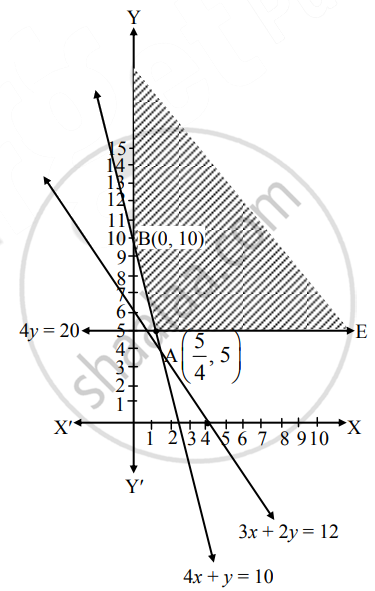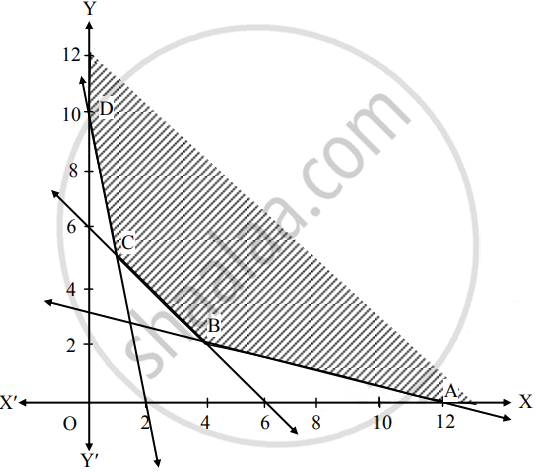Advertisements
Advertisements
Question
A chemist has a compound to be made using 3 basic elements X, Y, Z so that it has at least 10 litres of X, 12 litres of Y and 20 litres of Z. He makes this compound by mixing two compounds (I) and (II). Each unit compound (I) had 4 litres of X, 3 litres of Y. Each unit compound (II) had 1 litre of X, 2 litres of Y and 4 litres of Z. The unit costs of compounds (I) and (II) are ₹ 400 and ₹ 600 respectively. Find the number of units of each compound to be produced so as to minimize the cost
Solution
Let the chemist produce x units of compound I and y units of compound II.
Since x and y cannot be negative, x ≥ 0, y ≥ 0
The unit costs of compounds I and II are ₹ 400 and ₹ 600 respectively.
Total Cost = Z = 400x + 600y
We construct a table with constraints of X, Y and Z as follows:
| Compound I | Compound II | Least value | |
| X | 4 | 1 | 10 |
| Y | 3 | 2 | 12 |
| Z | – | 4 | 20 |
From the table, the constraints are
4x + y ≥ 10
3x + 2y ≥ 12
4y ≥ 20
∴ Given problem can be formulated as follows:
Minimize Z = 400x + 600y
Subject to 4x + y ≥ 10
3x + 2y ≥ 12
4y ≥ 20, x ≥ 0, y ≥ 0
To draw the feasible region, construct table as follows:
| Inequality | 4x + y ≥ 10 | 3x + 2y ≥ 12 | 4y ≥ 20 |
| Corresponding equation (of line) | 4x + y = 10 | 3x + 2y = 12 | 4y = 20 |
| Intersection of line with X-axis | `(5/2, 0)` | (4, 0) | – |
| Intersection of line with Y-axis | (0, 10) | (0, 6) | (0, 5) |
| Region | Non-Origin side | Non-Origin side | Non-Origin side |
Shaded portion EABY is the feasible region, whose vertices are A and B(0, 10).
A is the point of intersection of the lines 4y = 20 and 4x + y = 10,
Solving the above equations, we get
x = `5/4`, y = 5
∴ A ≡ `(5/4, 5)`

Here, the objective function is
Z = 400x + 600y
∴ Z at A`(5/4, 5) = 400(5/4) + 600(5)`
= 500 + 3000
= 3500
Z at B (0, 10) = 400(0) + 600(10)
= 6000
∴ Z has minimum value 3500 at x = `5/4` and y = 5.
∴ The chemist should produce `5/4` units of compound I and 5 units of compound II to minimize the cost.
APPEARS IN
RELATED QUESTIONS
A firm manufactures 3 products A, B and C. The profits are Rs 3, Rs 2 and Rs 4 respectively. The firm has 2 machines and below is the required processing time in minutes for each machine on each product :
| Machine | Products | ||
| A | B | C | |
| M1 M2 |
4 | 3 | 5 |
| 2 | 2 | 4 | |
Machines M1 and M2 have 2000 and 2500 machine minutes respectively. The firm must manufacture 100 A's, 200 B's and 50 C's but not more than 150 A's. Set up a LPP to maximize the profit.
The corner points of the feasible region determined by the following system of linear inequalities:
2x + y ≤ 10, x + 3y ≤ 15, x, y ≥ 0 are (0, 0), (5, 0), (3, 4) and (0, 5). Let Z = px + qy, where p, q > 0. Condition on p and q so that the maximum of Z occurs at both (3, 4) and (0, 5) is
Solve the following L.P.P. by graphical method:
Maximize: Z = 10x + 25y
subject to 0 ≤ x ≤ 3,
0 ≤ y ≤ 3,
x + y ≤ 5.
Also find the maximum value of z.
Choose the correct alternative :
The maximum value of z = 5x + 3y. subject to the constraints
Choose the correct alternative :
The maximum value of z = 10x + 6y, subjected to the constraints 3x + y ≤ 12, 2x + 5y ≤ 34, x ≥ 0, y ≥ 0 is.
Fill in the blank :
The region represented by the in equations x ≤ 0, y ≤ 0 lines in _______ quadrants.
The constraint that a factory has to employ more women (y) than men (x) is given by _______
The region represented by the inequalities x ≥ 0, y ≥ 0 lies in first quadrant.
State whether the following is True or False :
The region represented by the inqualities x ≤ 0, y ≤ 0 lies in first quadrant.
Solve the following problem :
A company manufactures bicyles and tricycles, each of which must be processed through two machines A and B Maximum availability of machine A and B is respectively 120 and 180 hours. Manufacturing a bicycle requires 6 hours on machine A and 3 hours on machine B. Manufacturing a tricycle requires 4 hours on machine A and 10 hours on machine B. If profits are ₹ 180 for a bicycle and ₹ 220 on a tricycle, determine the number of bicycles and tricycles that should be manufacturing in order to maximize the profit.
Solve the following problem :
A person makes two types of gift items A and B requiring the services of a cutter and a finisher. Gift item A requires 4 hours of cutter's time and 2 hours of finisher's time. B requires 2 hours of cutters time, 4 hours of finishers time. The cutter and finisher have 208 hours and 152 hours available times respectively every month. The profit of one gift item of type A is ₹ 75 and on gift item B is ₹ 125. Assuming that the person can sell all the items produced, determine how many gift items of each type should be make every month to obtain the best returns?
Choose the correct alternative:
The maximum value of Z = 3x + 5y subjected to the constraints x + y ≤ 2, 4x + 3y ≤ 12, x ≥ 0, y ≥ 0 is
State whether the following statement is True or False:
The point (6, 4) does not belong to the feasible region bounded by 8x + 5y ≤ 60, 4x + 5y ≤ 40, 0 ≤ x, y
If the feasible region is bounded by the inequations 2x + 3y ≤ 12, 2x + y ≤ 8, 0 ≤ x, 0 ≤ y, then point (5, 4) is a ______ of the feasible region
Maximize Z = 400x + 500y subject to constraints
x + 2y ≤ 80, 2x + y ≤ 90, x ≥ 0, y ≥ 0
Solve the LPP graphically:
Minimize Z = 4x + 5y
Subject to the constraints 5x + y ≥ 10, x + y ≥ 6, x + 4y ≥ 12, x, y ≥ 0
Solution: Convert the constraints into equations and find the intercept made by each one of it.
| Inequations | Equations | X intercept | Y intercept | Region |
| 5x + y ≥ 10 | 5x + y = 10 | ( ___, 0) | (0, 10) | Away from origin |
| x + y ≥ 6 | x + y = 6 | (6, 0) | (0, ___ ) | Away from origin |
| x + 4y ≥ 12 | x + 4y = 12 | (12, 0) | (0, 3) | Away from origin |
| x, y ≥ 0 | x = 0, y = 0 | x = 0 | y = 0 | 1st quadrant |
∵ Origin has not satisfied the inequations.
∴ Solution of the inequations is away from origin.
The feasible region is unbounded area which is satisfied by all constraints.
In the figure, ABCD represents
The set of the feasible solution where
A(12, 0), B( ___, ___ ), C ( ___, ___ ) and D(0, 10).
The coordinates of B are obtained by solving equations
x + 4y = 12 and x + y = 6
The coordinates of C are obtained by solving equations
5x + y = 10 and x + y = 6
Hence the optimum solution lies at the extreme points.
The optimal solution is in the following table:
| Point | Coordinates | Z = 4x + 5y | Values | Remark |
| A | (12, 0) | 4(12) + 5(0) | 48 | |
| B | ( ___, ___ ) | 4( ___) + 5(___ ) | ______ | ______ |
| C | ( ___, ___ ) | 4( ___) + 5(___ ) | ______ | |
| D | (0, 10) | 4(0) + 5(10) | 50 |
∴ Z is minimum at ___ ( ___, ___ ) with the value ___
A linear function z = ax + by, where a and b are constants, which has to be maximised or minimised according to a set of given condition is called a:-
Shraddho wants to invest at most ₹ 25,000/- in saving certificates and fixed deposits. She wants to invest at least ₹ 10,000/- in saving certificate and at least ₹ 15,000/- in fixed deposits. The rate of interest on saving certificate is 5% and that on fixed deposits is 7% per annum. Formulate the above problem as LPP to determine maximum income yearly.
